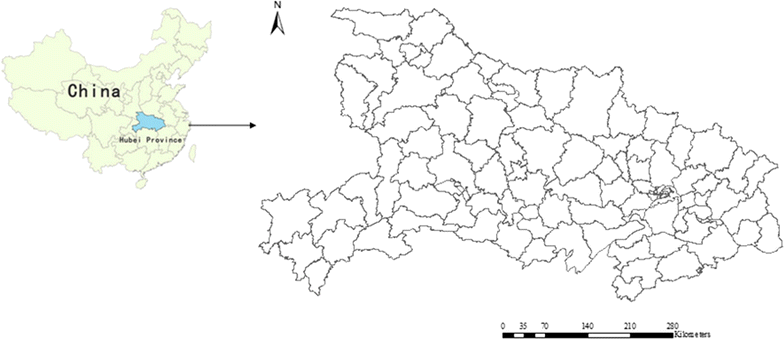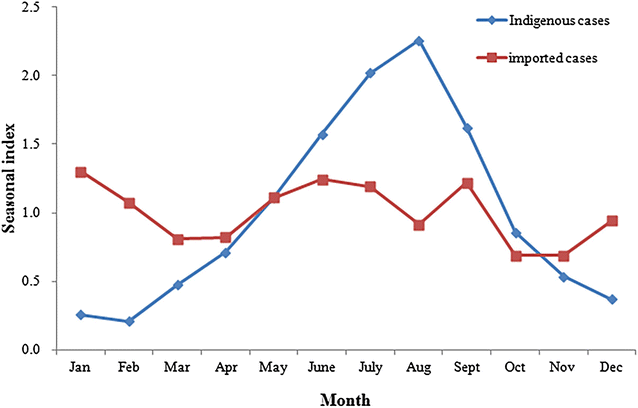Epidemiological characteristics of malaria from control to elimination in Hubei Province, China, 2005-2016
- PMID: 29448927
- PMCID: PMC5815180
- DOI: 10.1186/s12936-018-2207-7
Epidemiological characteristics of malaria from control to elimination in Hubei Province, China, 2005-2016
Abstract
Background: Hubei Province, China, has been operating a malaria elimination programme. This study aimed at investigating the epidemiologic characteristics of malaria in Hubei Province (2005-2016) to plan resource allocation for malaria elimination.
Methods: Data on all malaria cases from 2005 to 2016 in all counties of Hubei Province were extracted from a web-based reporting system. The numbers of indigenous and imported cases during the disease control (2005-2010) and elimination (2011-2016) stages, as well as their spatiotemporal distribution, were compared.
Results: A total of 8109 malaria cases were reported from 2005 to 2016 (7270 and 839 cases during the control and elimination stages, respectively). Between 2005 and 2010, indigenous malaria cases comprised the majority of total cases (7114/7270; 97.9%), and Plasmodium vivax malaria cases accounted for most malaria cases (5572/7270; 76.6%). No indigenous malaria cases have been reported in Hubei Province since 2013. Imported malaria cases showed a gradually increasing trend from 2011 to 2016, Plasmodium falciparum was the predominant species in these cases, and the number of counties with imported cases increased from 4 in 2005 to 47 in 2016. During the control and elimination stages, the most likely spatial clusters for indigenous cases included 13 and 11 counties, respectively. However, the cluster of indigenous malaria cases has not been identified since September 2011. For imported cases, the most likely cluster and three secondary clusters during both stages were identified.
Conclusions: Hubei Province has made significant achievements in controlling and eliminating malaria; however, the region now faces some challenges associated with the increasing number and distribution of imported malaria cases. Priorities for malaria elimination should include better management of imported malaria cases, prevention of secondary malaria transmission, and ensuring the sustainability of malaria surveillance.
Keywords: China; Elimination; Epidemiology; Hubei Province; Imported cases; Malaria; Spatiotemporal analysis.
Figures




Similar articles
-
Imported and indigenous Plasmodium Vivax and Plasmodium Falciparum malaria in the Hubei Province of China, 2005-2019.Malar J. 2023 Nov 6;22(1):334. doi: 10.1186/s12936-023-04752-7. Malar J. 2023. PMID: 37932775 Free PMC article.
-
Changing malaria transmission and implications in China towards National Malaria Elimination Programme between 2010 and 2012.PLoS One. 2013 Sep 9;8(9):e74228. doi: 10.1371/journal.pone.0074228. eCollection 2013. PLoS One. 2013. PMID: 24040210 Free PMC article.
-
Demonstration of indigenous malaria elimination through Track-Test-Treat-Track (T4) strategy in a Malaria Elimination Demonstration Project in Mandla, Madhya Pradesh.Malar J. 2020 Sep 17;19(1):339. doi: 10.1186/s12936-020-03402-6. Malar J. 2020. PMID: 32943065 Free PMC article.
-
Ready for malaria elimination: zero indigenous case reported in the People's Republic of China.Malar J. 2018 Aug 29;17(1):315. doi: 10.1186/s12936-018-2444-9. Malar J. 2018. PMID: 30157876 Free PMC article. Review.
-
[Role of primaquine in malaria control and elimination in French-speaking Africa].Bull Soc Pathol Exot. 2017 Aug;110(3):198-206. doi: 10.1007/s13149-017-0556-z. Epub 2017 Apr 17. Bull Soc Pathol Exot. 2017. PMID: 28417346 Review. French.
Cited by
-
Imported and indigenous Plasmodium Vivax and Plasmodium Falciparum malaria in the Hubei Province of China, 2005-2019.Malar J. 2023 Nov 6;22(1):334. doi: 10.1186/s12936-023-04752-7. Malar J. 2023. PMID: 37932775 Free PMC article.
-
Imported malaria cases in former endemic and non-malaria endemic areas in China: are there differences in case profile and time to response?Infect Dis Poverty. 2019 Jul 5;8(1):61. doi: 10.1186/s40249-019-0571-3. Infect Dis Poverty. 2019. PMID: 31272497 Free PMC article.
-
Epidemiology of Plasmodium falciparum Malaria and Risk Factors for Severe Disease in Hubei Province, China.Am J Trop Med Hyg. 2020 Oct;103(4):1534-1539. doi: 10.4269/ajtmh.20-0299. Am J Trop Med Hyg. 2020. PMID: 32700677 Free PMC article.
-
Molecular epidemiological surveillance of Africa and Asia imported malaria in Wuhan, Central China: comparison of diagnostic tools during 2011-2018.Malar J. 2020 Sep 3;19(1):321. doi: 10.1186/s12936-020-03387-2. Malar J. 2020. PMID: 32883296 Free PMC article.
-
Analysis of Severe and Relapse Risks of Imported Malaria in Five Provinces of China.Am J Trop Med Hyg. 2024 Dec 24;112(3):593-600. doi: 10.4269/ajtmh.24-0312. Print 2025 Mar 5. Am J Trop Med Hyg. 2024. PMID: 39719112
References
-
- WHO . World malaria report 2016. Geneva: World Health Organization; 2016.
-
- Sun JL, Zhou S, Geng QB, Zhang Q, Zhang ZK, Zheng CJ, et al. Comparative evaluation of the diagnosis, reporting and investigation of malaria cases in China, 2005–2014: transition from control to elimination for the national malaria programme. Infect Dis Poverty. 2016;5:65. doi: 10.1186/s40249-016-0163-4. - DOI - PMC - PubMed
-
- Ministry of Health . National malaria elimination action plan (2010–2020) Beijing: Ministry of Health; 2010.
-
- Cao J, Zhou SS, Zhou HY, Yu XB, Tang HL, Gao Q. Malaria from control to elimination in China: transition of goal, strategy and interventions. Chin J Schisto Control. 2013;25:439–443. - PubMed
MeSH terms
Grants and funding
LinkOut - more resources
Full Text Sources
Other Literature Sources

